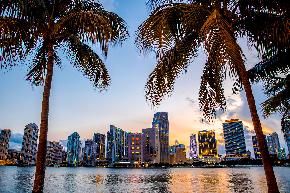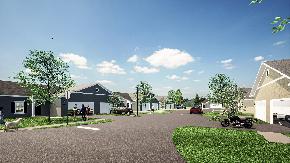Confronted by rising vacancy and limited retailer expansion, retail property owners in Broward County will compete aggressively to fill vacant space and retain tenants while attempting to mitigate rent reductions. Vacancy is expected to increase across most areas of the county, especially in unanchored strip centers measuring from 10,000 square feet to 30,000 square feet. Vacancy for unanchored strip centers rose more than 300 basis points to the mid-8% range last year and could push up an additional 300 basis points or more in 2009 as small retailers close in light of declining sales.
Areas where these assets continue to be significantly affected include Pompano Beach, Tamarac, Sunrise and Plantation. In eastern Fort Lauderdale, as well as in pockets within the western portion of the county, such as Coral Springs, properties have fared somewhat better due to stronger tenant mixes. Meanwhile, rents countywide will be pressured by the steady presence of sublease space and owners’ urgency to re-lease as quickly as possible.
In the investment market, cap rates for multi-tenant assets continue to inch upward. Properties pricing within this band reflect the current and forecast weakness in operating fundamentals and are expected to bring an increasing number of buyers back into the market. One issue that could limit deals in the months ahead is the likelihood that rents on re-leased space will be less than those on expiring leases.
As for single-tenant properties, sales of restaurants picked up at the end of last year. In the months ahead, expected closures of casual restaurant chains will bring to market a number of prime locations that will attract the attention of owners or franchisers of new dining concepts. Broward County strip centers with rents substantially below market rate will not incur significant rent reductions. As such, these assets may warrant closer examination from prospective buyers. In addition, opportunistic investors can expect to cash-on-cash returns in the mid teens for retail properties.
In Broward County, approximately 32,000 jobs will be cut this year, a 4.2% decline. In 2008, 26,900 positions were eliminated.
In 2009, completions are forecast to fall to 700,000 square feet from 1.7 million square feet last year. The 400,000-square-foot Village at Gulfstream Park, which is slated for delivery in the second half of this year, will be the largest project to come online.
A 280 basis point increase in the vacancy rate to 11.4% is projected this year. The forecast represents a 2.2% decline in occupied space, compared with a 1.3% drop in 2008, when vacancy rose 340 basis points. In 2009, asking rents are expected to slip 3.5% to $18.56 per square foot, following a 0.5% decrease last year. Effective rents of $16.09 per square foot mark a fall of 4.7% from 2008, when rents declined 2.1%.
Although borrowers are still achieving financing, lenders have become increasingly cautious underwriting retail property loans due to softening in fundamentals. Loan-to-values have declined, and lender spreads continue to reflect the increased risk in the retail sector. The average term for most new loans is five years, with few lenders willing to make a 10-year commitment in today’s market.
Furthermore, lenders are closely evaluating borrowers’ and tenants’ credit quality. In addition to borrowers’ ability to reach equity and operational targets for the subject properties, many lenders are evaluating entire portfolios to determine if investors’ other assets are at risk of becoming distressed and could therefore threaten the borrower’s financial position.
Despite government efforts to shore up the economy, the South Florida retail market will face a number of headwinds through much of 2009. Employers continue to shed jobs, with some of the most significant cuts coming in recent months. This year will present distinct challenges to retail investors. Each of the markets covered in this report is forecast to record job losses, declining retail sales, rising vacancy and falling rents.
As the downturn plays out in 2009 and a base of recovery forms in 2010, retail will start a new cycle in 2011 as new concepts emerge and the survivors begin to expand once again. Retail will do what it does best–reinvent, as has been proven time and again.
The views expressed here are those of the author and not of Incisive Media or its publications.
Richard Matricaria is a vice president investments in the Fort Lauderdale office of Marcus & Millichap Real Estate Investment Services. He can be reached at [email protected].





 Copyright © 2024 ALM Global, LLC. All Rights Reserved.
Copyright © 2024 ALM Global, LLC. All Rights Reserved.











